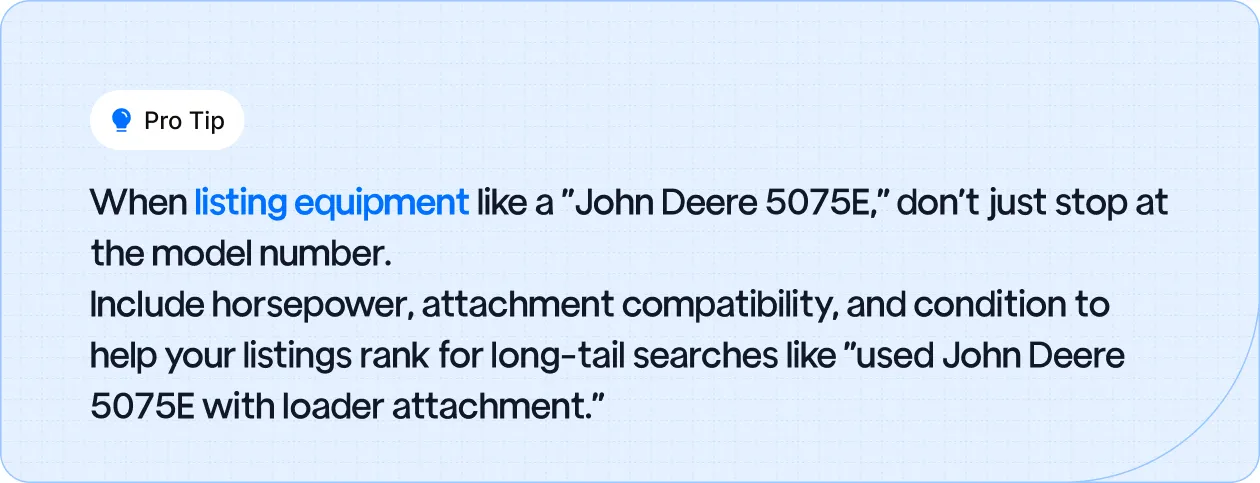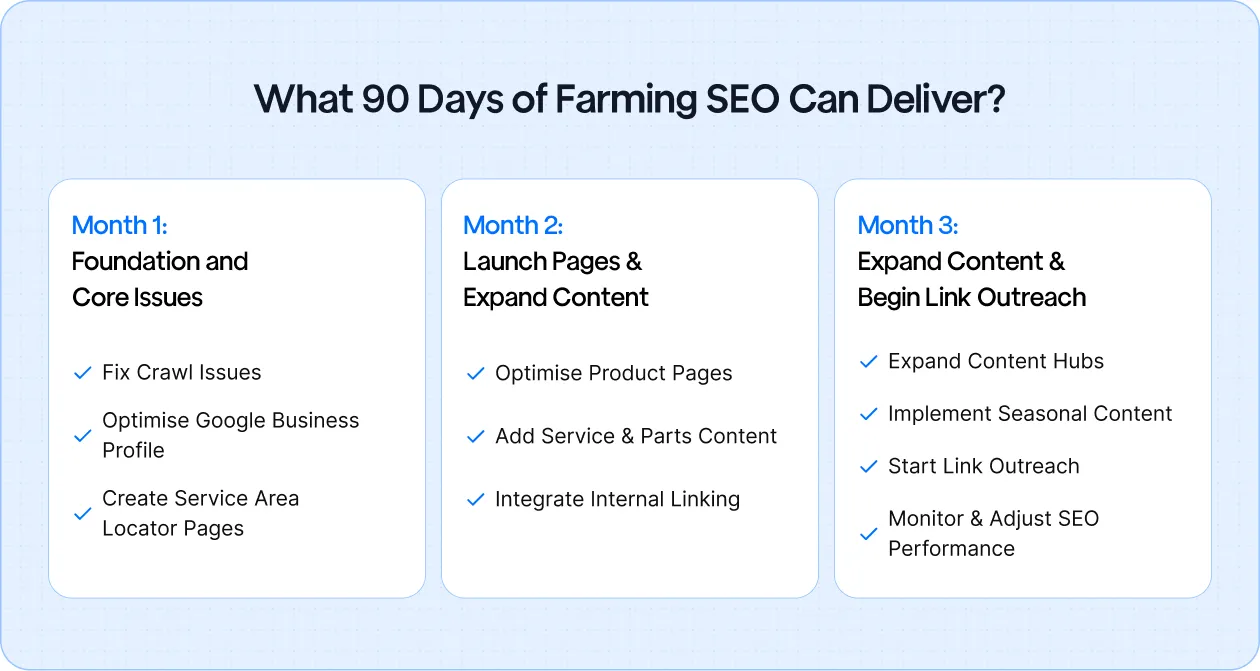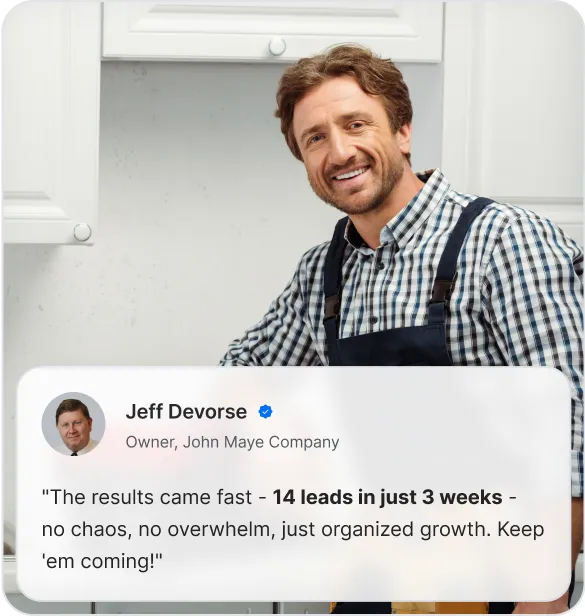If you’re in the business of selling farming equipment, you already know the frustration: farmers aren’t Googling "tractor dealer" or "agriculture equipment."
They're searching for "low-hour John Deere 5075E near me" or "combine repair in [city]." Generic SEO won’t help you capture these hyper-specific, local, and detail-driven searches.

And if your equipment listings don’t show up for these precise queries, you're missing out on buyers who are ready to purchase today. This blog will focus on how SEO services can drive local traffic, optimize your inventory for search engines, and turn search results into qualified leads.
Why Generic SEO Fails in Farming Equipment?
When it comes to farming equipment, most generic SEO advice misses the mark. Simply focusing on broad tactics like “publish more blogs” or “boost content quantity” does not address the unique needs of the farming industry.
Farmers are searching for specific equipment models, part numbers, and local services, not general dealership listings. If your SEO for manufacturers doesn’t address these specific queries, it won’t drive the qualified traffic your business needs to close sales.
Farming equipment buyers typically look for highly detailed information such as equipment hours, make/model specifics, and local availability. Without addressing these critical SEO elements, your business may fail to appear in the right search results when potential customers are ready to buy.
Making Your Equipment Listings Search-Friendly
For farming equipment businesses, it’s not just about having product listings online; it’s about optimizing those listings for search engines so they can be easily found by farmers actively searching for the equipment you sell.
Key Tactics:
- Structured Data: Use schema markup to provide search engines with specific details about your equipment, such as make, model, year, attachments, and horsepower. This will help your listings appear more prominently in search results.
- Mobile Optimization: Many farmers search for equipment directly from the field, so ensuring your listings are mobile-friendly is critical. A poor mobile experience can result in lost opportunities.

- Redirects for Sold Units: Keep sold equipment pages live with smart redirects. This ensures you retain the SEO value of those pages without resulting in broken links.

Optimizing for Local Search Visibility
For farming equipment businesses, local search is the key to attracting customers who are searching for equipment in their immediate area. Farmers prefer to buy equipment from nearby dealerships to avoid long shipping times and costs.
This is why local SEO is a must for your business.
Key Strategies:
- Google Business Profile (GBP): Optimise your profile for each location. Ensure that your business details are complete and consistent across all online platforms to help Google understand where your business operates and show you in local searches.
- Location Pages: Create specific location pages for each of the regions you serve. For example, a page like “Farm Equipment in [City Name]” will help capture searches from farmers in that particular area.
- Customer Reviews & Media: Encourage customers to leave reviews, and regularly update your GBP with fresh photos of your equipment, your store, and your team. This boosts your credibility and visibility.

Also Read: SEO for Industrial Companies: Why Your Customers Can't Find You
Capturing Profit Through Parts & Service Pages
While selling equipment is important, service and parts sales often provide steady, recurring revenue. Many farming businesses overlook the SEO potential of their parts and service pages, but these can be powerful assets for driving traffic and capturing leads.
Tactics for Optimising Service & Parts Pages:
- Optimise Parts Pages for OEM & Aftermarket Terms: Ensure that both OEM (Original Equipment Manufacturer) and aftermarket parts are covered with keywords that farmers are using, such as “John Deere tractor filter” or “Case IH hydraulic hose.”
- Seasonal Service Menus: Farmers need their equipment inspected and serviced before the busy seasons (planting, harvesting, etc.). Having seasonal service menus on your site helps capture those service needs.
- FAQ Sections: Adding an FAQ section to your service pages can also capture voice search traffic. Farmers often ask questions like “What parts fit my John Deere 5075E?” or “How do I prepare my tractor for winter?”

Content That Speaks Farmers' Language
Content marketing for farming equipment businesses needs to go beyond generic product descriptions. Farmers want content that addresses their challenges, whether it’s fixing a mechanical issue, finding the right equipment, or getting ready for a season.
Effective Content Strategies:
- Category Hubs: Create content hubs around key product categories like tractors, sprayers, combines, and balers. This type of content provides helpful guides, buying tips, and troubleshooting advice for each category.
- Demo Videos: Farmers rely on visual content to understand how equipment works. Offering detailed demo videos or troubleshooting guides can drive higher engagement.
- Seasonal Guides: Tailor content to the farming calendar, such as how to prepare equipment for planting or harvesting. These seasonal guides can capture traffic at peak times for those activities.
Building Authority in Agriculture
To stand out in a competitive market, you need to build your authority in the agricultural industry. This means positioning your business as a trusted resource for both information and services.
Ways to Build Authority:
- Earn Links from Agricultural Associations: Having backlinks from agriculture-focused websites, extension services, and ag colleges will boost your site’s credibility and domain authority.
- Publish Safety & Maintenance Tips: Content like farm safety guides or maintenance tips for specific equipment types often get picked up by industry publications or regional news outlets, which boosts your SEO rankings.
- Share Customer Success Stories: Local case studies or customer testimonials showing how your equipment has helped farmers can significantly increase trust in your brand.

Using Marketplaces Without Losing Buyers
Marketplaces like TractorHouse, AgDealer, and MachineryTrader are excellent platforms for showcasing farm equipment, but they shouldn’t be your only source of leads. Funneling traffic back to your own website should always be part of your strategy.
Marketplace Strategies:
- Syndicate Listings: Post your equipment listings on major farming marketplaces to extend your reach.
- Canonical URLs: Make sure the canonical URLs on your marketplace listings point back to your own website. This ensures you retain SEO value.
- Drive Marketplace Traffic Back to Your Site: After attracting buyers from marketplace platforms, direct them to your site for additional services like financing, trade-ins, and servicing.
Must Read: PPC for Manufacturing: The Smart Way to Drive Leads and Slash Wasted Spend
Measuring ROI in Farming SEO
It’s not enough to just track rankings or traffic; you need to measure real-world business impact. How many of the people visiting your site are converting into qualified leads or actual sales? Here's how to track and measure your SEO ROI.

- Indexation of Equipment Pages: Track how often search engines index your equipment pages and show up in search results.
- Lead Conversions: Track quote requests, phone calls, and form submissions to measure how many leads are converting from organic traffic.
- Service Bookings & Parts Sales: Monitor service bookings and parts sales that are driven by organic traffic.
Also Read: How Manufacturers Can Win More Leads With SEO
What 90 Days of Farming SEO Can Deliver?

A well-structured SEO strategy for farming equipment businesses can deliver tangible results in as little as three months. By focusing on high-impact actions in the first 90 days, you’ll see improvements in search rankings, traffic, and lead generation. Here's what to expect in your first 90 days:
Month 1: Laying the Foundation and Addressing Core Issues
The first month is about establishing a strong SEO foundation. It’s crucial to address any technical SEO issues and optimise for local search, a key factor in farming equipment SEO.
Key Actions in Month 1:
- Fix Crawl Issues: Use Google Search Console to identify crawl errors like broken links and poor page structure. These issues can prevent search engines from properly indexing your pages, harming visibility.
- Optimise Google Business Profile (GBP): Ensure your GBP is fully filled out, including business hours, services, and location. Upload high-quality images, encourage reviews, and update regularly to boost your local visibility. A strong GBP presence can help you secure a spot in the local map pack.
- Create Service Area Locator Pages: Farmers search for equipment near them, so build location-specific pages for each region you serve. These pages should include service details and local contact information, making it easy for both search engines and customers to find you.
![An optimised GBP will help you appear when farmers search for "farm equipment near me" or "tractor repairs in [location]".](https://cdn.prod.website-files.com/6614dca1d3aa7b076d6f3004/68d3c44c6a5eeb3b9516d1bf_346540ca.webp)
Month 2: Launch Optimised Product Pages and Expand Content
By the second month, you’ll have established the foundation. Now, it’s time to focus on optimising your product pages and expanding content to target more specific search queries.
Key Actions in Month 2:
- Optimise Product Pages: Update or create product pages with detailed SEO-friendly descriptions, including make, model, hours of use, and condition. Use structured data (schema markup) for each listing to help search engines understand the specific equipment and improve visibility.
- Add Service & Parts Content: Ensure your service and parts pages are optimised with seasonal service offerings (e.g., pre-harvest checks, winterisation) and part-specific details. Farmers often search by part numbers and model compatibility, so focus on these specifics.
- Integrate Internal Linking: As you add new content, link relevant product pages, blogs, and service pages together. This improves site structure, making it easier for both users and search engines to navigate.

Month 3: Expand Content Hubs, Implement Seasonal Content, and Start Link Outreach
The third month focuses on scaling up and diversifying your content to reach a broader audience. Now it’s time to build authority with targeted seasonal content and link-building strategies.
Key Actions in Month 3:
- Expand Content Hubs: Create category-specific hubs around farming equipment like tractors, sprayers, and combines. These hubs should include detailed guides, FAQs, and troubleshooting tips, becoming a go-to resource for your target audience.
- Implement Seasonal Content: Create seasonal blog posts (e.g., "Preparing Your Tractor for Spring Planting" or "Winter Maintenance for Combines") that align with farming activities. These posts will capture traffic when farmers are looking for relevant advice.
- Start Link Outreach: Begin outreach to authoritative farming blogs, agricultural websites, and local news outlets for backlinks. These links boost your site’s credibility and help you rank higher in search results.
- Monitor & Adjust SEO Performance: Use tools like Google Analytics to track progress. Assess page performance, traffic growth, and conversion rates. Adjust your strategy as needed to focus on areas that are driving the most conversions.

After 90 Days: Tracking Success and Scaling
By the end of the 90-day period, you should start seeing improved local rankings, increased organic traffic, and higher-quality leads. However, SEO is an ongoing process.
The next phase involves building on your progress by refining your strategy, scaling content efforts, and continuously improving on-page and off-page SEO for sustained growth.
SEO Packages for Farming Equipment Businesses
Your SEO strategy should be tailored to your business model. Whether you’re a single-store dealership or an OEM distributor, your SEO needs will vary. Here’s how to structure your SEO packages to suit different business types.
Customised SEO Packages:

- Single-Store Operations: Optimise Google Business Profile and set up individual product listings.
- Multi-Location Networks: Build location-specific pages and upload bulk product listings.
- OEM/Distributors: Develop model hubs, microsites, and co-op SEO kits to support resellers.
Turning Search Into Sales
For farming equipment businesses, SEO isn't just about gaining traffic; it’s about moving equipment, selling parts, and filling service bays. Companies that focus on local SEO, targeted product listings, and seasonal content will be the ones farmers find first when they need equipment, parts, or repairs.
The reality is that a DIY approach to SEO won’t be enough to keep up with the competition. To succeed, you need a strategic, comprehensive SEO plan tailored to the unique needs of farming equipment sales and services.
FAQs
Q1. Why is local SEO important for farming equipment businesses?
A1. Local SEO is critical because most farming equipment buyers prefer to purchase from nearby dealerships to avoid shipping costs and long delivery times. Optimizing for local search ensures your business shows up when farmers are searching for equipment or services in your area, increasing the likelihood of conversion.
Q2. How do I optimise my farming equipment product pages for SEO?
A2. Optimise your product pages by including detailed descriptions, make/model, condition, attachments, and hours of use. Use schema markup for structured data to help search engines understand the specific details. Don't forget to include location-based keywords and long-tail keywords for better visibility.
Q3. What content should I create to attract more traffic to my farming equipment website?
A3. Create category hubs that focus on different types of equipment (tractors, sprayers, combines), offer seasonal content (e.g., pre-harvest checklists), and produce problem-solving videos or troubleshooting guides. Farmers often search for specific solutions, so content that answers their questions directly will help boost engagement and traffic.
Q4. How can I improve my Google Business Profile for farming equipment?
A4. To improve your Google Business Profile, ensure that all information is complete and accurate, including hours of operation, services, and location. Add high-quality photos, encourage customers to leave reviews, and regularly update the profile with new content. An optimised GBP helps you appear in the local map pack and boosts your local search visibility.
Q5. Why is link-building important for SEO in farming equipment businesses?
A5. Link-building from reputable sources like agriculture blogs, extension services, and local media outlets helps increase your site's credibility and domain authority, which are crucial for ranking higher in search results. High-quality backlinks from relevant sites signal to search engines that your content is authoritative and trustworthy.
Q6. How long does it take to see results from SEO for farming equipment businesses?
A6. SEO for farming equipment businesses can start showing results in as little as 90 days. By focusing on technical SEO, local search optimisation, content creation, and link-building strategies, you can improve your visibility, traffic, and lead generation in the short term. However, continuous SEO efforts are necessary for long-term success.





















.webp)








.webp)
.svg)


.svg)
.svg)
.svg)




.svg)




.svg)